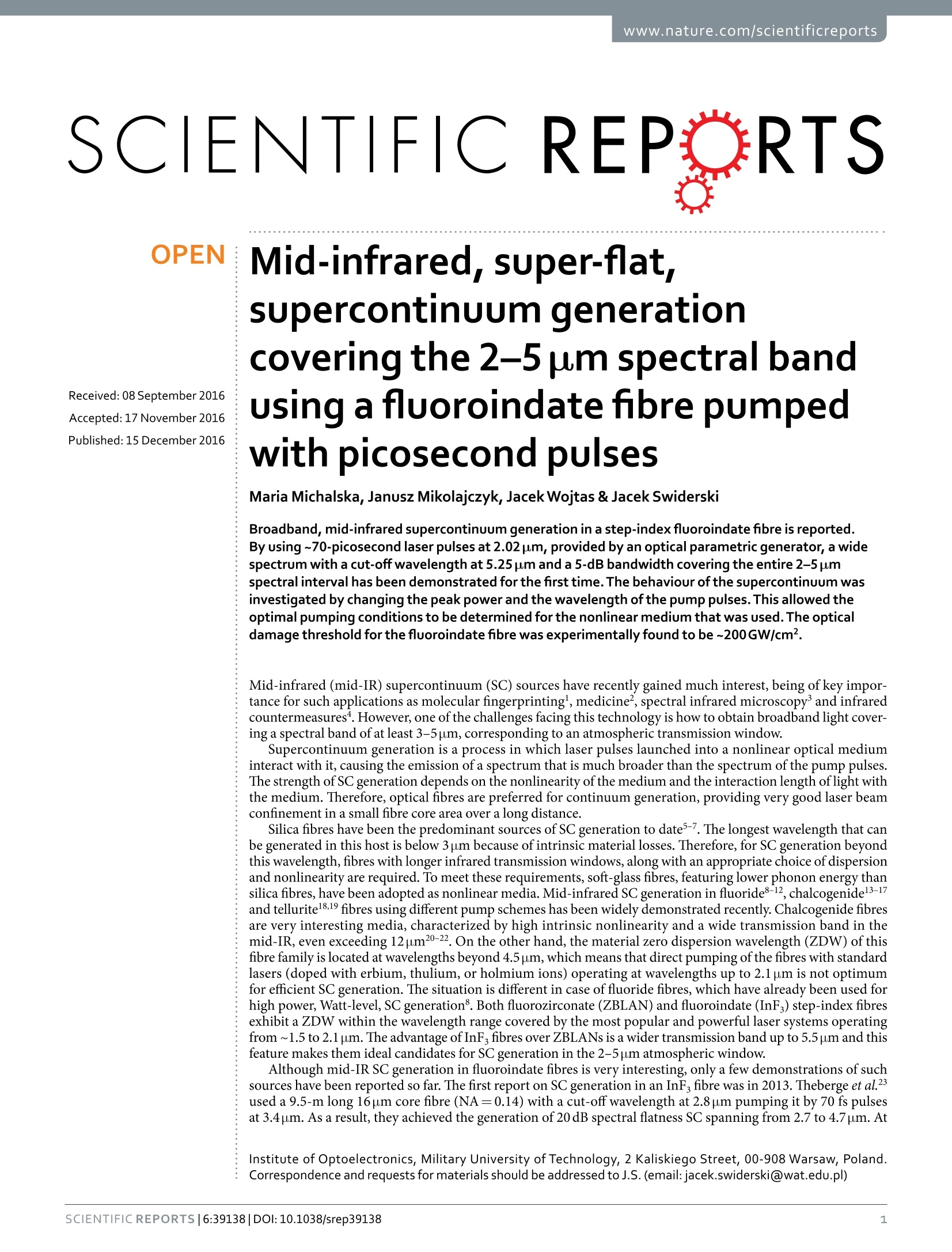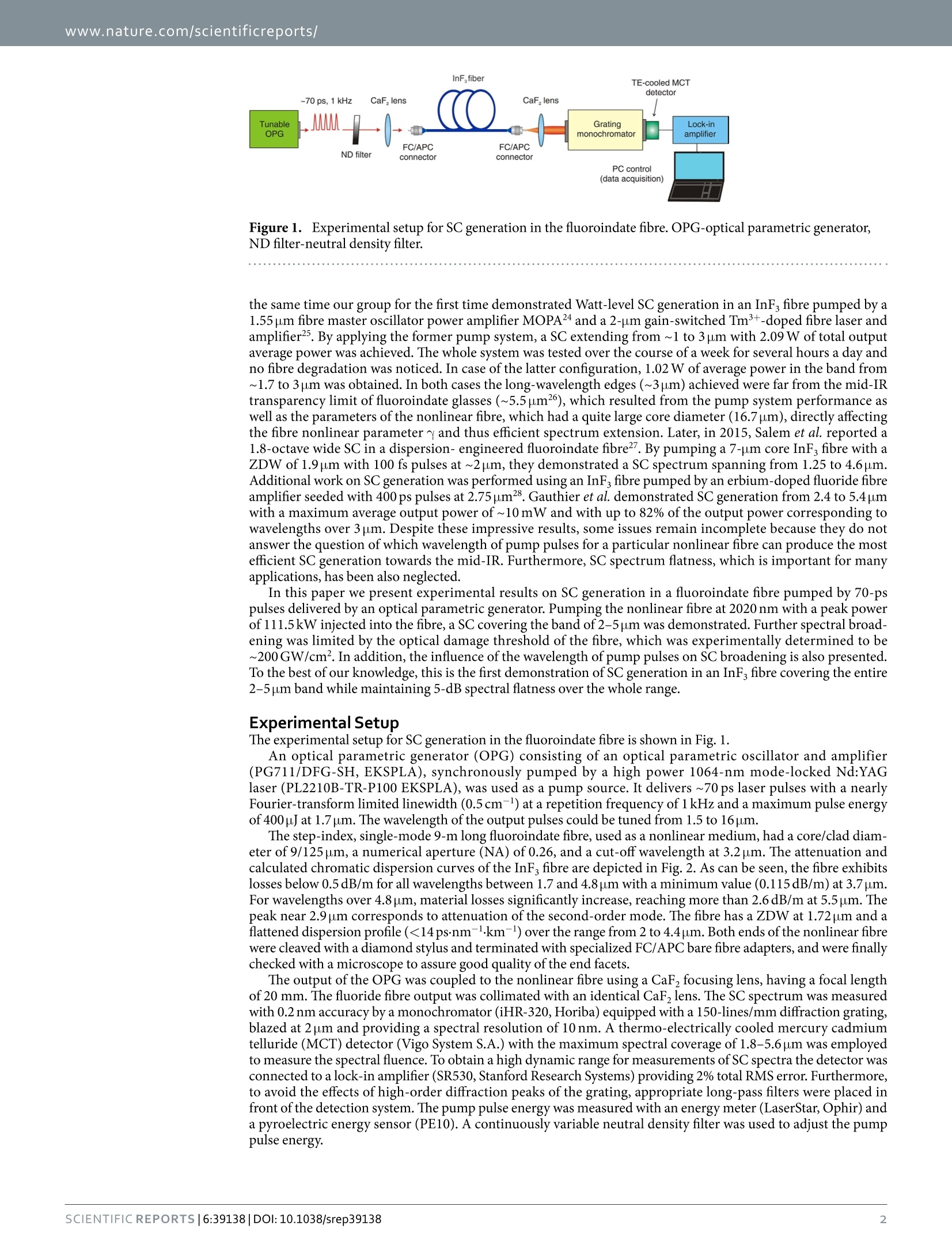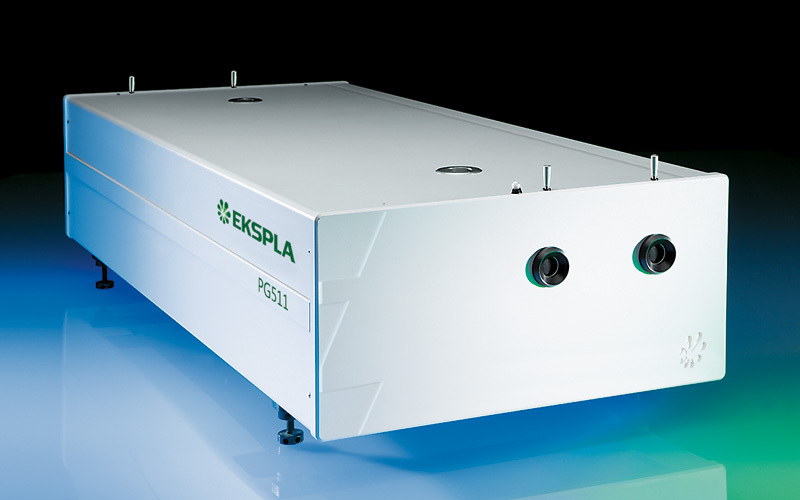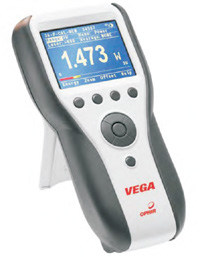方案详情文
智能文字提取功能测试中
www.nature.com/scientificreports SCIENTIFIC REP :RTS Received:08 September 2016 Accepted:17 November 2016 Published: 15 December 2016 Mid-infrared, super-flat,supercontinuum generationcovering the 2-5 um spectral bandusing a fluoroindate fibre pumpedwith picosecond pulses Maria Michalska, Janusz Mikolajczyk, Jacek Wojtas & Jacek Swiderski Broadband, mid-infrared supercontinuum generation in a step-index fluoroindate fibre is reported.By using~70-picosecond laser pulses at 2.02 pm, provided by an optical parametric generator,a widespectrum with a cut-off wavelength at 5.25 um and a 5-dB bandwidth covering the entire 2-5 pmspectral interval has been demonstrated for the first time. The behaviour of the supercontinuum wasinvestigated by changing the peak power and the wavelength of the pump pulses. This allowed theoptimal pumping conditions to be determined for the nonlinear medium that was used. Theopticaldamage threshold for the fluoroindate fibre was experimentally found to be~200GW/cm². Mid-infrared (mid-IR) supercontinuum (SC) sources have recently gained much interest, being of key impor-tance for such applications as molecular fingerprinting, medicine , spectral infrared microscopy and infraredcountermeasures4. However, one of the challenges facing this technology is how to obtain broadband light cover-ing a spectral band of at least 3-5 um, corresponding to an atmospheric transmission window. Supercontinuum generation is a process in which laser pulses launched into a nonlinear optical mediuminteract with it, causing the emission of a spectrum that is much broader than the spectrum of the pump pulses.The strength of SC generation depends on the nonlinearity of the medium and the interaction length oflight withthe medium. Therefore, optical fibres are preferred for continuum generation, providing very good laser beamconfinement in a small fibre core area over a long distance. Silica fibres have been the predominant sources of SC generation to date5-7. The longest wavelength that canbe generated in this host is below 3 pm because of intrinsic material losses. Therefore, for SC generation beyondthis wavelength, fibres with longer infrared transmission windows, along with an appropriate choice of dispersionand nonlinearity are required. To meet these requirements, soft-glass fibres, featuring lower phonon energy thansilica fibres, have been adopted as nonlinear media. Mid-infrared SC generation in fluoride8-12, chalcogenidel3-17and telluritel8,19 fibres using different pump schemes has been widely demonstrated recently. Chalcogenide fibresare very interesting media, characterized by high intrinsic nonlinearity and a wide transmission band in themid-IR, even exceeding 12 um20-22.On the other hand, the material zero dispersion wavelength (ZDW) of thisfibre family is located at wavelengths beyond 4.5 u.m, which means that direct pumping of the fibres with standardlasers (doped with erbium, thulium, or holmium ions) operating at wavelengths up to 2.1 pm is not optimumfor efficient SC generation.The situation is different in case of fluoride fibres, which have already been used forhigh power, Watt-level, SC generation. Both fluorozirconate(ZBLAN) and fluoroindate (InF;) step-index fibresexhibit a ZDW within the wavelength range covered by the most popular and powerful laser systems operatingfrom~1.5 to 2.1 um. The advantage of InF, fibres over ZBLANs is a wider transmission band up to 5.5 u.m and thisfeature makes them ideal candidates for SC generation in the 2-5 pm atmospheric window. Although mid-IR SC generation in fluoroindate fibres is very interesting, only a few demonstrations of suchsources have been reported so far. The first report on SC generation in an InF, fibre was in 2013. Theberge et al.used a 9.5-m long 16 um core fibre (NA=0.14) with a cut-off wavelength at 2.8 pm pumping it by 70 fs pulsesat 3.4 pm. As a result, they achieved the generation of 20 dB spectral flatness SC spanning from 2.7 to 4.7 pm. At Institute of Optoelectronics, Military University of Technology, 2 Kaliskiego Street, 00-908 Warsaw, Poland.Correspondence and requests for materials should be addressed to J.S.(email: jacek.swiderski@wat.edu.pl) Figure 1. Experimental setup for SC generation in the fluoroindate fibre. OPG-optical parametric generator,ND filter-neutral density filter. the same time our group for the first time demonstrated Watt-level SC generation in an InF, fibre pumped by a1.55 p.m fibre master oscillator power amplifier MOPA24 and a 2-um gain-switched Tm+-doped fibre laser andamplifier2. By applying the former pump system, a SC extending from ~1 to 3 pm with 2.09 W of total outputaverage power was achieved. The whole system was tested over the course of a week for several hours a day andno fibre degradation was noticed. In case of the latter configuration, 1.02 W of average power in the band from~1.7 to 3 um was obtained. In both cases the long-wavelength edges (~3 um) achieved were far from the mid-IRtransparency limit of fluoroindate glasses (~5.5pm26), which resulted from the pump system performance aswell as the parameters of the nonlinear fibre, which had a quite large core diameter (16.7pm), directly affectingthe fibre nonlinear parameter y and thus efficient spectrum extension. Later, in 2015, Salem et al. reported a1.8-octave wide SC in a dispersion- engineered fluoroindate fibre. By pumping a 7-um core InF, fibre with aZDW of 1.9 pm with 100 fs pulses at ~2pm, they demonstrated a SC spectrum spanning from 1.25 to 4.6 p.m.Additional work on SC generation was performed using an InF, fibre pumped by an erbium-doped fluoride fibreamplifier seeded with 400 ps pulses at 2.75 p.m28. Gauthier et al. demonstrated SC generation from 2.4 to 5.4 p.mwith a maximum average output power of~10 mW and with up to 82% of the output power corresponding towavelengths over 3 um. Despite these impressive results, some issues remain incomplete because they do notanswer the question of which wavelength of pump pulses for a particular nonlinear fibre can produce the mostefficient SC generation towards the mid-IR. Furthermore, SC spectrum flatness, which is important for manyapplications,has been also neglected. In this paper we present experimental results on SC generation in a fluoroindate fibre pumped by 70-pspulses delivered by an optical parametric generator. Pumping the nonlinear fibre at 2020 nm with a peak powerof 111.5kW injected into the fibre, a SC covering the band of 2-5 pm was demonstrated. Further spectral broad-ening was limited by the optical damage threshold of the fibre, which was experimentally determined to be~200GW/cm. In addition, the influence of the wavelength of pump pulses on SC broadening is also presented.To the best of our knowledge, this is the first demonstration of SC generation in an InF, fibre covering the entire2-5pm band while maintaining 5-dB spectral flatness over the whole range. ExperimentalSetup The experimental setup for SC generation in the fluoroindate fibre is shown in Fig. 1. An optical parametric generator (OPG) consisting of an optical parametric oscillator and amplifier(PG711/DFG-SH, EKSPLA), synchronously pumped by a high power 1064-nm mode-locked Nd:YAGlaser (PL2210B-TR-P100 EKSPLA), was used as a pump source. It delivers ~70 ps laser pulses with a nearlyFourier-transform limited linewidth (0.5cm-) at a repetition frequency of 1 kHz and a maximum pulse energyof 400pJ at 1.7 pm. The wavelength of the output pulses could be tuned from 1.5 to 16 u.m. The step-index, single-mode 9-m long fluoroindate fibre, used as a nonlinear medium, had a core/clad diam-eter of 9/125 u.m, a numerical aperture (NA) of 0.26, and a cut-off wavelength at 3.2 u.m. The attenuation andcalculated chromatic dispersion curves of the InF, fibre are depicted in Fig. 2. As can be seen, the fibre exhibitslosses below 0.5 dB/m for all wavelengths between 1.7 and 4.8 um with a minimum value (0.115dB/m) at 3.7 um.For wavelengths over 4.8 p.m, material losses significantly increase, reaching more than 2.6 dB/m at 5.5 pm. Thepeak near 2.9 pm corresponds to attenuation of the second-order mode. The fibre has a ZDW at 1.72 pm and aflattened dispersion profile (<14psnm-.km-) over the range from 2 to 4.4pm. Both ends of the nonlinear fibrewere cleaved with a diamond stylus and terminated with specialized FC/APC bare fibre adapters, and were finallychecked with a microscope to assure good quality of the end facets. The output of the OPG was coupled to the nonlinear fibre using a CaF, focusing lens, having a focal lengthof 20 mm. The fluoride fibre output was collimated with an identical CaF lens. The SC spectrum was measuredwith 0.2 nm accuracy by a monochromator (iHR-320, Horiba) equipped with a 150-lines/mm diffraction grating,blazed at 2 um and providing a spectral resolution of 10 nm. A thermo-electrically cooled mercury cadmiumtelluride (MCT) detector (Vigo System S.A.) with the maximum spectral coverage of 1.8-5.6 um was employedto measure the spectral fluence. To obtain a high dynamic range for measurements of SC spectra the detector wasconnected to a lock-in amplifier (SR530, Stanford Research Systems) providing 2% total RMS error. Furthermore,to avoid the effects of high-order diffraction peaks of the grating, appropriate long-pass filters were placed infront ofthe detection system. The pump pulse energy was measured with an energy meter (LaserStar, Ophir) anda pyroelectric energy sensor (PE10). A continuously variable neutral density filter was used to adjust the pumppulse energy. 30 Figure2. Dispersion (a) and attenuation (b) curves of the fluoroindate fibre. The data were provided by themanufacturer (Thorlabs Inc). Wavelength (nm) Wavelength (nm) Wavelength (nm) Wavelength (nm) Figure 3. Evolution of the SC spectrum in the InF, fibre for different wavelengths of pump pulses: 1750 nm (a),1900 nm (b), 2000nm (c), 2020 nm (d), 2250nm (e), and 2500nm (f). The pump pulse energy launched into thefibre was maintained at~2.7pJ. Results and Discussion Supercontinuum generation in the InF, fibre was investigated as a function of pump wavelength and pulse energy/peakpower launched into the fibre. First, we varied the wavelength in an attempt to maintain the pump pulse energylaunched into the fibre at a constant level, set to be~2.7pJ (corresponding to ~35 kW of peak power). The aim ofthis part of the study was to find the optimal pump wavelength for the nonlinear medium that was being used,providing efficient SC spectrum extension towards the mid-IR. The selected pump wavelengths output fromthe OPG corresponded to the anomalous region of the fiber dispersion, close to the ZDW and also far from thispoint. Figure 3 plots the evolution of the SC spectra for six different pump wavelengths and for the same energyof pumping pulses injected into the InF, fibre. The recorded spectra were corrected for the detector and gratingresponsivities. The spectrum of the generated SC was recorded after passing through a long-pass filter with a Figure 4. SC spectra obtained from the 9-m-long InF, fibre pumped at 2.02 um, recorded for injected pumppulse energies of~2.7pJ (36.3kW),3.9pJ(52.4kW),5.5pJ(73.9kW), and 8.3pJ(111.5kW). cut-off edge at 2 um. The broadest spectrum, spreading to 4380 nm, was measured when pumping at 2.02 pm.Moving the OPG to 2.25 pm and 2.5um also provided efficient mid-IR SC generation, but it was narrowed byover 140 nm. Applying shorter wavelengths of 1.75 p.m, 1.8pm, and 2 pum caused the output SC spectra to extendto 3380 nm, 3800 nm, and 4180 nm, respectively. Surprisingly, pumping the nonlinear fibre close to the ZDW(at 1.75 pm and 1.9um) did not cause as efficient spectrum extension towards the red wavelengths as in case of the2.02 um pump wavelength. It is commonly known that to achieve efficient spectrum broadening towards longerwavelengths, a nonlinear fibre should preferably be pumped in the anomalous dispersion region, relatively closeto its zero group velocity dispersion (GVD) point29,30. However, in our case, the optimum pump wavelength wasexperimentally determined to be 2020 nm, which is 300 nm away from the calculated ZDW. One possible expla-nation is that the actual ZDW of the InF, fibre is shifted towards longer wavelengths (close to 2um), comparedwith the ZDW determined from the calculated dispersion curve presented in Fig. 2a. The verification of this issuewill be the subject of our further research. Nevertheless, this part ofthe experiment allowed us to choose the mostappropriate pump wavelength for the fluoroindate fibre. The observation of SC evolution at shorter wavelengths(<2pm) was not carried out, mainly because of detection system limitations. In the second part of the experiment we examined SC evolution as a function of pump pulse energy, whilemaintaining the pump wavelength at 2020 nm. Figure 4 shows the resulting SC spectra emitted from the InFsfibre recorded for the pump pulse energies of ~2.7pJ, 3.9p.J, 5.5 pJ, and 8.3 pJ with corresponding pulse peakpower (assuming a Gaussian shaped pulse) of 36.3kW, 52.4kW,73.9kW, and111.5kW, respectively. The growthof the long-wavelength edge can be observed as a result of increasing the pump energy. For the lowest appliedpulse energy, 2.7pJ, the spectrum extends to ~4.4p.m. The spectral range was considered according to the noiselevel of the detection system. When the pulse energy was increased to 3.9pJ, the SC was further broadened by400 nm into the mid-IR. Applying 5.5 pJ of energy yielded an SC with a spectrum that extended to 5 pm. At thehighest coupled pulse energy of 8.3pJ, the spectrum covered the entire 2-5 um interval with a cut-off wavelengthat 5.25 um, representing over an octave of optical bandwidth. A signal drop at ~4.2 u.m corresponds to absorptionby CO2 molecules in the detection system. The 5-dB flatness of the spectral intensity, achieved with 8.3pJ pumppulses, was maintained in the wavelength interval from 2 to 5 p.m (a span of 3000 nm), which represents a signif-icant advance compared with other reports on SC generation in fluoroindate fibres23-28. The dynamics of the SC generation in optical fibres is well known.When the fibre is pumped with picosec-ond or nanosecond pulses in the anomalous dispersion region, modulation instability (interpreted as parametricfour-wave mixing) is the main phenomenon in the first step of SC generation. This modulation instability leads tothe temporal breakup of pump pulses into a distributed spectrum of many shorter subpulses, which then propa-gate through the fibre and undergo fission, Raman-induced frequency red-shift, and dispersive wave generation3. As shown in Fig. 4 the spectrum broadens progressively with pump pulse energy until the damage threshold ofthe fibre is reached, this being the main limitation of further SC broadening. The damage threshold was reachedwhen the energy of the pumping pulses launched into the fibre was ~9.5pJ. Assuming a Gaussian field profile ofthe pulse, the damage threshold corresponded to 128kW of peak power and ~200GW/cm’of power density onthe fibre facet. These levels were additionally verified by pumping three other pieces of InF, fibre, all of whichdemonstrated similar values for the damage threshold. Conclusion In conclusion, we report, what we believe to be the first demonstration of 5-dB flat SC emitted by a step indexfluoroindate (InF) fibre covering the entire 2-5 pm spectral band. Pumping the nonlinear fibre with 70-ps pulseswith a peak power of 111.5 kW at 2020 nm yields broadband mid-IR SC generation with a cut-off wavelength at 5.25 u.m. The main limitation of further spectrum extension was the damage to the InF, fibre at higher pumppulse energies; the damage threshold was experimentally determined to be~200 GW/cm. In the near future weare planning to compare the experimental results with numerical simulations. Furthermore, the planned meas-urements of the dispersion profile of the nonlinear fiber should give us more information on the dynamics of SCgeneration for different pump wavelengthsIS. ( References ) 1. Schliesser, A., Picque, N.& Hansch, T. W. Mid-infrared frequency combs. Nat. Photonics 6, 440-449 (2012). ( 2. S eddon, A. Mid-Infrared (IR)-a ho t topic: The potential for using mid-IR light for non-invasive early detection o f s k in cander i n v ivo. Phys. Status Solidi . B 250, 1020-1027(2013). ) ( 3. Dupont,S. et al. IR microscopy utilizing intense supercontinuum light source. Opt. Express 20, 4887-4892 (2012). ) ( 4. Bekman, H. H. P.T., van d e n Heuvel, J. C., van Putten,F. J. M. & Schleijpen, R . Development of a mid-infrared laser for study of i nfrared countermeasures techniques. Proc. SPIE 5615,27-38(2004). ) ( 5 . S widerski, J. & Maciejewska, M. Watt-level, al l -fibre supercontinuum source based on telecom-grade fibre components. Appl. Phys B. 109,177-181(2012). ) ( 6. Yin, K. L i , L. , Yao, J., Zhan g , B. & Hou, J. Ov e r 100 W ultra-flat broadband short-wave infrared supercontinuum generation i n athulium-doped fibre amplifier. Opt. Lett . 40, 4787-4790 (2015). ) 7. Tao, M. et al. Super-flat supercontinuum generation from a Tm-doped fibre amplifier. Sci.Rep. 6, 23759 (2016). ( 8. Swiderski,J. High-power mid-infrared supercontinuum sources: Current status and future perspectives. Prog.Quant. Electron. 38, 1 89-235(2014). ) ( 9. Yang, W., Zhang, B., Yin, K., Zhou, X. & Hou,J . High power al l fibre mid-IR supercontinuum generation in a ZBLAN fibre pumpedby a 2 pm MOPA s y stem. Opt. E xpress 21 ,1 9732-19742(2013). ) ( 10. Liu, K., Liu,J., Shi, H., Tan, F. & Wang, Pu. High power mid-infrared supercontinuum generation in a single-mode ZBLAN f ibre with up to 21.8 W average output power. Opt. Express 22, 24384-24391 (2014). ) ( 11. . Gauthier, J.-C., Fortin, V., Duva l , S., Vallee, R. & Bernier, M. In-amplifier mid-infrared supercontinuum generation. Opt.Lett. 40, 5247-5250(2015). ) ( 12. Kneis, C. et al. High-peak-power single-oscillator actively Q-switched mode-locked Tm +-doped fibre laser and its application for high-average output power mid-IR supercontinuum generation in a ZBLAN fibre. Opt. Lett. 41,2545-2548 (2016). ) ( 13. Theberge, F. et al. Multioctave infrared supercontinuum generation in large-core AszS, fibres. Opt. Lett. 39,6474-6477 (2014). ) ( 14. Shiryaev, V. S. & Churbanov, M. F. Trends and prospects for development of chalcogenide fibres for mid-infrared tr a nsmission. . J . Non-Cryst. Solids 377,225-230(2013). ) 15. Kubat, I. et al. Mid-infrared supercontinuum generation to 12.5 u.m in large NA chalcogenide step-index fibres pumped at 4.5 pm.Opt. Express 22, 19169-19182 (2014). 16. Yao, J. et al. Mid-infrared supercontinuum generation based on cascaded Raman scattering in a few-mode AsS fibre pumped by athulium-doped fibre laser. Opt. Express 24,14717-14724(2016). 17. Kim, W. H. et al. Recent progress in chalcogenide fibre technology at NRL. J. Non-Cryst. Solids 431,8-15(2016). 18. Thapa, R. et al. Mid-IR supercontinuum generation in ultra-low loss, dispersion-zero shifted tellurite glass fibre with extendedcoverage beyond 4.5 p.m. Proc. SPIE 8898, 889808(2013). 19. Domachuk, P. et al. Over 4000 nm bandwidth of mid-IR supercontinuum generation in sub-centimeter segments of highlynonlinear tellurite PCFs.Opt. Express 16, 7161-7168 (2008). 20. Sanghera, J. S.et al. Active and passive chalcogenide glass optical fibres for IR applications: a review. J. Non-Cryst. Solids 354,462-467(2008). 21. Cheng, T.et al. Mid-infrared supercontinuum generation spanning 2.0 to 15.1 pm in a chalcogenide step-index fibre. Opt. Lett. 41,2117-2120(2016). 22. Petersen, C. R. et al. Mid-infrared supercontinuum covering the 1.4-13.3 pm molecular fingerprint region using ultra-high NAchalcogenide step-index fibre. Nat. Photonics 8, 830-834 (2014). 23. Theberge, F. et al. Mid-infrared supercontinuum generation in fluoroindate fibre. Opt Lett 38, 4683-4685 (2013). 24. Swiderski,J. et al. High average power supercontinuum generation in a fluoroindate fibre. Laser Phys. Lett. 11, 015106 (2014). 25. Swiderski, J., Michalska, M., Kieleck, C., Eichhorn, M. & Maze, G. High power supercontinuum generation in fluoride fibrespumped by 2 um pulses. IEEE Photon. Technol. Lett.26, 150-153 (2014). 26. Saad, M. Indium fluoride glass fibres, Proc. SPIE 8275,82750D(2012). 27. Salem, R. et al. Mid-infrared supercontinuum generation spanning 1.8 octaves using step-index indium fluoride fibre pumped by afemtosecond fibre laser near 2 pm. Opt. Express 23, 30592-30602(2015). 28. Gauthier,J.-C. et al. Mid-IR supercontinuum from 2.4 to 5.4pm in a low-loss fluoroindate fibre. Opt. Lett. 41,1756-1759(2016). 29. Dudley, J. M. & Taylor, J. R. Supercontinuum generation in optical fibres (Cambridge University Press, 2010). 30. Agrawal, G. P. Nonlinear Fibre Optics, 4th edition (Academic Press, Boston, 2007). 31. Genty,G., Coen, S. & Dudley, J.M. Fibre supercontinuum sources.J. Opt. Soc. Am. B. 24, 1771-1785 (2007). Acknowledgements Authors would like to acknowledge financial support from the Polish National Science Centre (Project No. UMO-2014/14/M/ST7/00868). The research is carried out within the confines of NATO SET-224 Research Task Group“Coherent Mid-Infrared Fibre Source Technology. AuthorContributions M.M. and J.S. proposed the conception of the experiment, performed the measurements, analysed the data,contributed to the scientific discussion and prepared the manuscript. J.W. and J.M. made the optical parametricgenerator available and calibrated the detection system. All authors reviewed the manuscript. AdditionalInformation Competing financial interests: The authors declare no competing financial interests. How to cite this article: Michalska, M. et al. Mid-infrared, super-flat, supercontinuum generation coveringthe 2-5 um spectral band using a fluoroindate fibre pumped with picosecond pulses. Sci. Rep. 6, 39138;doi: 10.1038/srep39138 (2016). Publisher’s note: Springer Nature remains neutral with regard to jurisdictional claims in published maps andinstitutional affiliations. This work is licensed under a Creative Commons Attribution 4.0 Internati onal License. The imagesor other third party material in this article are included in the article’s Creative Commons license,unless indicated otherwise in the credit line; if the material is not included under the Creative Commons license,users will need to obtain permission from the license holder to reproduce the material. To view a copy of thislicense, visit http://creativecommons.org/licenses/by/4.0/ @ The Author(s) 2016 SCIENTIFICREPORTS|:DOI:srep Broadband, mid-infrared supercontinuum generation in a step-index fluoroindate fibre is reported. By using ~70-picosecond laser pulses at 2.02 μm, provided by an optical parametric generator, a wide spectrum with a cut-off wavelength at 5.25 μm and a 5-dB bandwidth covering the entire 2–5 μm spectral interval has been demonstrated for the first time. The behaviour of the supercontinuum was investigated by changing the peak power and the wavelength of the pump pulses. This allowed the optimal pumping conditions to be determined for the nonlinear medium that was used. The optical damage threshold for the fluoroindate fibre was experimentally found to be ~200 GW/cm2.
关闭-
1/6

-
2/6

还剩4页未读,是否继续阅读?
继续免费阅读全文产品配置单
北京欧兰科技发展有限公司为您提供《掺氟光纤中发射光谱检测方案(激光产品)》,该方案主要用于太阳能中发射光谱检测,参考标准《暂无》,《掺氟光纤中发射光谱检测方案(激光产品)》用到的仪器有Ekspla PGx11 窄线宽皮秒光学参量发生器。
我要纠错
相关方案






 咨询
咨询




